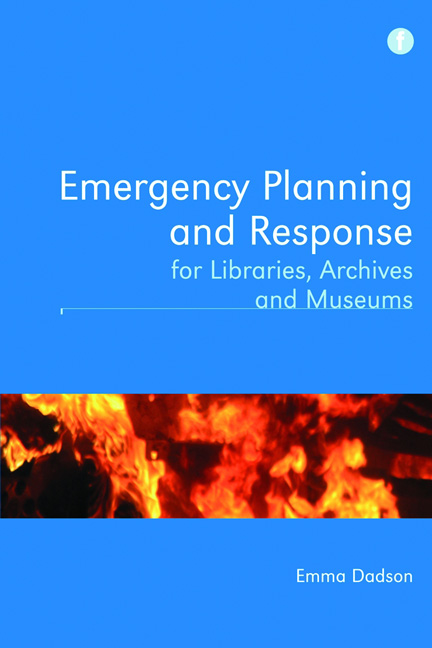Book contents
- Frontmatter
- Contents
- Foreword
- Preface
- Acknowledgements
- 1 Introduction
- 2 Case studies
- 3 Roles and responsibilities
- 4 Incident control
- 5 Planning the recovery operation
- 6 Collections salvage
- 7 Supplementary content
- 8 Dealing with the building
- 9 Business continuity
- 10 Ensuring the plan's efficacy
- 11 Conclusion
- Bibliography and references
- Index
- Frontmatter
- Contents
- Foreword
- Preface
- Acknowledgements
- 1 Introduction
- 2 Case studies
- 3 Roles and responsibilities
- 4 Incident control
- 5 Planning the recovery operation
- 6 Collections salvage
- 7 Supplementary content
- 8 Dealing with the building
- 9 Business continuity
- 10 Ensuring the plan's efficacy
- 11 Conclusion
- Bibliography and references
- Index
Summary
Introduction
The procedures an organization uses to report and respond to an incident – so that it is controlled and contained as quickly as possible – are discussed in this chapter. It examines how to organize a response to an emergency safely and sensibly in order to limit damage and subsequent impacts, and considers which incidents might constitute an ‘emergency’ and therefore fall within the scope of the plan.
The impact of successful incident control
If the first phase of incident response is managed successfully, its discovery, reporting and immediate control, the potential for reduction in damage and subsequent service disruption is significant. If 100 litres of water discharge from a burst pipe each minute, obviously swift control of the leak, containment of the seeping water, and protection of collections will all serve to minimize the impact of this emergency, potentially averting substantial damage to the collections and building.
Unfortunately, this emergency phase can prove very challenging and very overwhelming. Some individuals can panic and start taking immediate action without any recourse to procedures, or even consideration of their own safety or that of others. Sometimes the shock of the situation can make individuals freeze, making action very difficult as the individual cannot think clearly or act decisively, as demonstrated in this account by Carrie Taylor of the Wordsworth Trust:
No coherent thoughts raced through my head, only to contact the curator even though it was a Saturday. Within a minute other members of the security and estates team were assembled. Stopcocks needed to be located and at first noone could remember where they were, only the horror of uncertainty. We thought the main one was located in the road way under the snow and ice and it took some considerable time and effort to locate the grid.
It can be very difficult to predict how individuals will react in these suddenly pressurized situations. Some individuals can remain composed and think about safety sensibly and take appropriate actions to contain the incident as quickly as possible with or without a plan. This is where a plan should fit in: it can corral a diverse group of people into responding to an emergency situation in the most appropriate way, which will ensure damage is minimized and safety risks are assessed and reduced.
- Type
- Chapter
- Information
- Publisher: FacetPrint publication year: 2012



